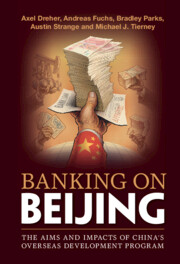Book contents
- Banking on Beijing
- Banking on Beijing
- Copyright page
- Contents
- Figures
- Tables
- Acknowledgments
- Abbreviations
- 1 Why Do We Know So Little about the Aims and Impacts of China’s Overseas Development Program?
- 2 The Journey to Global Creditor
- 3 Counting and Comparing Apples and Dragon Fruits
- 4 Follow the Money
- 5 Apples and Dragon Fruits
- 6 Aid à la Carte
- 7 Paving the Way to Growth and Development?
- 8 Poisonous Dragon Fruits?
- 9 Banking on the Belt and Road
- Postscript: Analysis of China’s Overseas Development Program During the BRI Era With an Updated Dataset
- References
- Index
6 - Aid à la Carte
The Subnational Distribution of Chinese Development Finance
Published online by Cambridge University Press: 21 April 2022
- Banking on Beijing
- Banking on Beijing
- Copyright page
- Contents
- Figures
- Tables
- Acknowledgments
- Abbreviations
- 1 Why Do We Know So Little about the Aims and Impacts of China’s Overseas Development Program?
- 2 The Journey to Global Creditor
- 3 Counting and Comparing Apples and Dragon Fruits
- 4 Follow the Money
- 5 Apples and Dragon Fruits
- 6 Aid à la Carte
- 7 Paving the Way to Growth and Development?
- 8 Poisonous Dragon Fruits?
- 9 Banking on the Belt and Road
- Postscript: Analysis of China’s Overseas Development Program During the BRI Era With an Updated Dataset
- References
- Index
Summary
This chapter investigates the motivations of recipient governments who seek out Chinese development projects. We examine how host country leaders shape the ways that Chinese development finance is allocated across subnational jurisdictions. First, we evaluate whether China’s allocation of aid and debt within countries flows to areas with higher levels of socioeconomic need. Second, we explore whether political leaders manipulate incoming financial flows from China to advance their own political interests. We do so by examining whether and when funds from Beijing favor the home provinces of political leaders. Finally, we compare and contrast the ways in which Chinese and World Bank development projects are subnationally distributed. To do so, we assign latitude and longitude coordinates to the specific locations where China implemented its de- velopment projects.Our findings indicate that Chinese development finance does not go to the geographic areas within recipient countries where it is most needed: much of it ends up in wealthier provinces. In addition, Chinese development projects favor politically privileged jurisdictions: the home provinces of political leaders receive substantially more Chinese development finance in countries with competitive elections, and even more at election time. This is a problem from a development perspective because the average home province of a political leader is significantly wealthier than the rest of the country.
- Type
- Chapter
- Information
- Banking on BeijingThe Aims and Impacts of China's Overseas Development Program, pp. 159 - 191Publisher: Cambridge University PressPrint publication year: 2022

